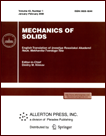 | | Mechanics of Solids
A Journal of Russian Academy of Sciences | | Founded
in January 1966
Issued 6 times a year
Print ISSN 0025-6544
Online ISSN 1934-7936 |
Archive of Issues
| Total articles in the database: | | 13362 |
| In Russian (»Á‚. –ņÕ. Ő““): | | 8178
|
| In English (Mech. Solids): | | 5184 |
|
| << Previous article | Volume 60, Issue 3 / 2025 | Next article >> |
| Mandeep Kaur, Satish Kumar, and Vikas Sharma, "Size-Dependent Thin Plate Dynamics: Investigating Anti-Plane and In-Plane Wave Propagation with Generalized Boundary Restraints," Mech. Solids. 60 (3), 2234-2256 (2025) |
| Year |
2025 |
Volume |
60 |
Number |
3 |
Pages |
2234-2256 |
| DOI |
10.1134/S0025654425601065 |
| Title |
Size-Dependent Thin Plate Dynamics: Investigating Anti-Plane and In-Plane Wave Propagation with Generalized Boundary Restraints |
| Author(s) |
Mandeep Kaur (Department of Mathematics, Thapar Institute of Engineering and Technology, Patiala, Punjab, India)
Satish Kumar (Department of Mathematics, Thapar Institute of Engineering and Technology, Patiala, Punjab, India)
Vikas Sharma (Department of Mathematics, Lovely Professional University, Phagwara, Punjab, India, vikassharma10a@yahoo.co.in, vikas.sharma@lpu.co.in) |
| Abstract |
Despite extensive research on plates with either traction-free boundaries or rigidly fixed faces, many real-world situations involve boundary conditions that fall between these two extremes. To bridge the gap between these fundamental casesótraction-free and fixed-boundary conditionsóit is reasonable to assume that the fields at the boundaries follow a Hooke-type law, representing elastic restraints at the surfaces. These generalized boundary conditions, known as Elastically Restrained Boundary Conditions (ERBC), are applied in the normal, shear, and rotational directions to study anti-plane (SH) and in-plane (P-SV) wave phenomena in a microstructural elastic plate, modeled using the consistent couple stress theory. The ERBC incorporate stiffness coefficients to relate normal, tangential, and rotational stresses to the corresponding displacements within the plate. Analytical derivation of the dispersion relations is carried out to examine the wave propagation characteristics under varying boundary conditions. Special cases, such as stress-free boundary conditions (similar to Rayleigh-Lamb type waves), mixed boundary conditions, and rigid boundary conditions, emerge as limiting cases. The study explores the influence of the characteristic length scale parameter (l) introduced by the consistent couple stress model, along with stiffness coefficients like normal stiffness, shear stiffness, and rotational stiffness, on wave propagation. It also investigates the transition between rigidly fixed and stress-free boundary conditions, offering insights into how different boundary conditions affect wave behavior in a thin microstructural elastic plate. |
| Keywords |
SH waves, P-SV waves, couple stress theory, restrained boundary conditions, stress-free boundary conditions, rigid boundary conditions |
| Received |
06 March 2025 | Revised |
22 April 2025 | Accepted |
23 April 2025 |
| Link to Fulltext |
|
| << Previous article | Volume 60, Issue 3 / 2025 | Next article >> |
|
 If you find a misprint on a webpage, please help us correct it promptly - just highlight and press Ctrl+Enter If you find a misprint on a webpage, please help us correct it promptly - just highlight and press Ctrl+Enter
|
|

 Russian
Russian  English
English